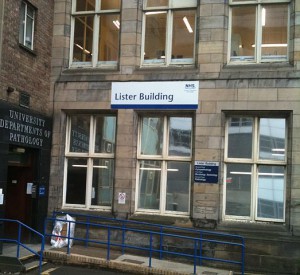This is the second in a series of posts about the content which is being created for the UK Medical Heritage Library. John More, Collections Manager and College Librarian, College of Science and Engineering Glasgow University Library, takes up the story or Glasgow’s long association with advances in medicine.
The University of Glasgow is the second oldest in Scotland and is a broad based, research intensive institution with a global reach. Founded in 1451, the study of medicine was first mentioned in 1637 when Robert Mayne was appointed Professor of Medicine. However, in reality, the modern medical school came into being when William Cullen was appointed professor in 1751. There are strong links with the development of health care systems in Glasgow and beyond; in particular, with the treatment of mental illness and infectious diseases. Glasgow University has one of the largest and most prestigious medical schools in Europe. It has led the way in many advances in medicine and is renowned for pioneering teaching methods; for example, John Macintyre opened the world’s first hospital radiology department at Glasgow Royal Infirmary in 1896. Other leading figures associated with medicine at Glasgow University include William Hunter (anatomy), Joseph Lister (antiseptic surgery), William Macewen (brain surgery), William Gairdner (pathology), Thomas McCall Anderson (dermatology), John Glaister (forensic medicine) and Guido Pontecorvo (genetics).

The Glasgow Coma Scale (GCS) is used in hospitals all over the world to provide a quick and reliable assessment of the conscious state of a patient with a suspected brain injury. The University’s School of Veterinary Medicine was founded in 1862 and is one of the country’s leading veterinary schools. The Dental School is the second largest in the UK and was recently listed as the country’s leading centre of excellence in the subject. In addition, the University has a Centre for the History of Medicine and a Centre for molecular parasitology.
The University Library’s general medical collections support teaching and research across all the subjects in its medical schools and are particularly strong in anatomy, surgery, clinical medicine, public health, sanitation and homeopathic medicine. Equally, there is good collection of relevant material on antibiotics, medical botany, health spas and the treatment of consumption, and the combined topics of alcoholism and temperance.
Within the University Library’s Special Collections there are outstanding resources for research on the history of medicine generally, and in the areas of anatomy, obstetrics and gynaecology in particular, largely owing to the superb library of William Hunter, a leading eighteenth century figure in these areas. More recent material includes the papers and library of R.D. Laing, the controversial psychiatrist and author.
In terms of 19th century collections we have many works on Glasgow hospitals, including the Royal Infirmary opened in 1794, and public health, such as Robert Perry’s ‘Facts and Observations on the Sanitary State of Glasgow’ (1844) which includes an early example of statistical mapping of an epidemic and was published and printed at the Gartnavel Asylum.
